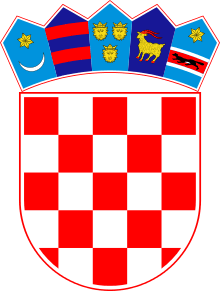Transport in Croatia
Transport in Croatia relies on several main modes, including transport by car, train, boat and plane. Road transport incorporates a comprehensive network of state, county and local routes augmented by a network of highways for long-distance travelling. Water transport can be divided into sea, based on the ports of Rijeka, Ploče, Split and Zadar, and river transport, based on Sava, Danube and, to a lesser extent, Drava. Croatia has 68 airports, nine of which are international. The country also has several airlines, of which the most notable are Croatia Airlines and Trade Air. Rail transport is fairly developed, with dual track and electrification not very common, although high-speed tilting trains are used on some routes. However, bus still tends to be more common than rail as a mode of inter-city transport.
.svg.png)
Airports
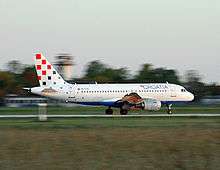
There are international airports in Zagreb, Split, Dubrovnik, Zadar, Pula, Rijeka (on the island of Krk), Osijek, Bol and Mali Lošinj.
Currently, the following low cost airlines are flying to Croatia: Jet2, EasyJet, Eurowings, TUIfly, Ryanair, Thomson, flydubai and Wizz Air. Major established companies that fly to Croatia include the domestic Croatia Airlines (member of the Star Alliance), Air France, Aeroflot, Lufthansa, Emirates, Finnair, Austrian Airlines, KLM, Qatar Airways, Swiss International Air Lines, British Airways and Turkish Airlines. Seasonal intercontinental flights also operate from and to Croatia.
In January 2011 the U.S. Federal Aviation Administration (FAA) assessed the Government of Croatia's Civil Aviation Authority announcing that Croatia complied with International Civil Aviation Organization (ICAO) aviation safety standards for oversight of Croatia's air carrier opinions.[1] IASA Category 1 rating and that Croatian air carriers are authorized Croatia to the US.
Statistics:
Overall: 68 airports (2004 estimate)
Airports with paved runways (2004 est.):
- total: 23
- 10,000 ft (3,000 m) or more: 2
- 8,000 to 9,999 ft (2,438 to 3,048 m): 6
- 5,000 to 7,999 ft (1,524 to 2,438 m): 2
- 3,000 to 4,999 ft (914 to 1,524 m): 4
- under 3,000 ft (910 m): 9
Airports with unpaved runways (2004 est.):
- total: 45
- 5,000 to 7,999 ft (1,524 to 2,438 m): 1
- 3,000 to 4,999 ft (914 to 1,524 m): 7
- under 3,000 ft (910 m): 37
Heliports: 3 (2008)
Airports:
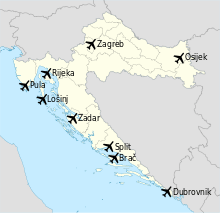
Rail transport
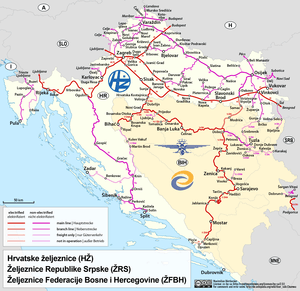
The Croatian railway network is classified into three groups: railways of international, regional and local significance.[2][3] The most important railway lines follow Pan-European corridors V (branch B) and X, they connect at Zagreb with each other. There are connections to the railway networks of Slovenia, Hungary, Bosnia and Herzegovina and Serbia.
The railways need to be modernized because the lion's share of the railway infrastructure in Croatia dates back from the pre-WW2 period and more than half of the core routes were, in fact, built during the Habsburg Monarchy i.e. before the First World War. As a result, most of the routes are not electrified, are only single track traffic around 'bends' and lag significantly behind the West-European standards. Some limited improvements, however, have been made in recent times. A result of this has been an increase in the maximum speed on the railway line on the Pan-European Corridor X, from the Slovenian border via Zagreb, Novska, Vinkovci to the Serbian border (lines M101 through M105). In places the line's speed limit has been raised from 80 km/h (50 mph) to 120 km/h (75 mph), and plans have been made to raise this further to 160 km/h (100 mph) on certain sections. The railway line of the Pan-European Corridor Vb, from the Hungarian border via Koprivnica, Zagreb, Karlovac to the Port of Rijeka (lines M201, M102 and M202) has a slow section through Gorski Kotar, which is planned to undergo a major overhaul. The railway line of the Pan-European Corridor Vc, from the Hungarian border via Beli Manastir, Osijek, Đakovo or Vinkovci, Slavonski Šamac, to the border of Bosnia and Herzegovina (lines M301, M302 and M303), is also being modernised, the aim is to allow speeds of up to 160 km/h along the entire length.
The official rail speed record in Croatia is 181 km/h (112 mph). Maximum speed reached in regular service is 160 km/h (99 mph) on parts of the Novska–Tovarnik line.
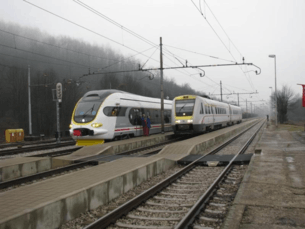
Recently Croatian Railways introduced a series of modern tilting trains produced by the German branch of Bombardier Transportation. They usually deployed on the mountainous route between the two largest Croatian cities, Zagreb and Split. Although they can sometimes be found on other routes in the country. Contrary to regular overnight fast trains between Zagreb and Split with scheduled travelling time of circa 8 hours in total, tilting trains on the Zagreb–Split route (lines M202 and M604) offer passengers a faster journey with a journey time of about 6 hours.
Croatian Railways aims to revitalize rail traffic through further improvements. Thus, establishing rail as serious competitor to the car, particularly during the busy the summer months.
Croatian Railways' plan to build their first high-speed railway service is progressing. Construction of an entirely new line from Karlovac to Rijeka, and reconstruction of the line from the Hungarian border to Karlovac should have originally begun in the fall of 2007. The line is going to be entirely electrified and in order to speed up the journey even more shall be 269 km (167 mi) long from end to end, 61 km (38 mi) shorter than the existing line. The journey from Zagreb to Rijeka will be cut to one hour compared to 4 hours with the existing track. The line is intended to carry the increasing amount of goods that enter Europe, at the Croatian Port of Rijeka and are then transported to destinations across central and eastern Europe. The plans have originally foreseen 2008-2010 as the date for completion. Due to the world economic crisis, building start date is prolonged to a yet undefined date. The project plans have been drawn, however.
Pan-European Corridor X is going to be upgraded to higher speed sometime in the future. Possibly by building a new high capacity connection line from Sisak via Kutina to Lipovljani. The line should allow for speeds of up to 250 km/h.
Statistics:
Railway length (as of 2011):[4]
- total: 2,722 km (1,691 mi)
- standard gauge, 1,435 mm (4 ft 8 1⁄2 in): 2,722 km (1,691 mi) (984 km or 611 mi electrified)
Rail links with adjacent countries
Road transport
From the time of Napoleon and building the Louisiana road, the road transport in Croatia has significantly improved, topping most European countries. Croatian highways are widely regarded as being one of the most modern and safe in Europe.[5][6] This is because the largest part of the Croatian motorway and expressway system (autoceste and brze ceste, resp.) has been recently constructed (mainly in the 2000s), and further construction is continuing. The motorways in Croatia connect most major Croatian cities and all major seaports. The two longest routes, the A1 and the A3, span the better part of the country and the motorway network connects most major border crossings.
Tourism is of major importance for the Croatian economy, and as most tourists come to vacation in Croatia in their own cars, the highways serve to alleviate summer jams. They have also been used as a means of stimulating urgently needed economic growth, and for the sustainable development of this country. Croatia now has a considerable highway density for a country of its size, helping it cope with the consequences of being a transition economy and having suffered in the Croatian War of Independence.
As of 2011, Croatia has a total of 29,410 kilometers (18,270 mi) of roads.[4] Travel Organiser (2007)
Traffic laws
The traffic signs adhere to the Vienna Convention on Road Signs and Signals.
The general speed limits are:
- in inhabited areas 50 km/h
- outside of inhabited areas 90 km/h
- on marked expressways 110 km/h
- on marked motorways 130 km/h
In 2004, a controversial new traffic law was introduced, which provides for drastic safety measures for drunken or dangerous driving: it reduced the blood alcohol limit to 0‰ of alcohol in blood. In 2008 this law was reversed to 0.5‰ of alcohol in blood.
Some of the more technical safety measures include that all new Croatian tunnels have modern safety equipment and there are several control centers, which monitor highway traffic.
Motorways
Motorways (Croatian: Autocesta, plural Croatian: autoceste) in Croatia applies to dual carriageway roads with at least two traffic lanes in each driving direction and an emergency lane. Direction road signs at Croatian motorways have green background with white lettering similar to the Swiss Autobahn. The designations of motorways are "A" and the motorway number. As of 2014, the Croatian motorway network is 1,313.8 kilometres (816.4 mi) long.[7]
The list of completed motorways is as follows (see individual articles for further construction plans and status):
- A1, Zagreb - Bosiljevo - Split - Ploče (E71, E65)
- A2, Zagreb - Krapina - Macelj (E59)
- A3, Bregana - Zagreb - Lipovac (E70)
- A4, Goričan - Varaždin/Čakovec - Zagreb (E71)
- A5, Osijek - Đakovo - Sredanci (E73)
- A6, Bosiljevo - Rijeka (E65)
- A7, Rupa - Rijeka bypass (E61)
- A9, Umag - Pula (E751)
- A10, A1 Ploče interchange - Metković border crossing
- A11, Velika Gorica - Buševec
Toll is charged on most Croatian motorways, and exceptions are the A11 motorway, Zagreb bypass and Rijeka bypass, as well as sections adjacent to border crossings (except eastbound A3). Payment in kuna, all major credit cards and euros are accepted at all toll gates. Most motorways are covered by the closed toll collection system, where a driver receives a ticket at the entrance gates and pays at the exit gates according to the number of sections travelled. Open toll collection is used on some bridges and tunnels and short stretches of tolled highway, where drivers immediately pay the toll upon arriving. Various forms of prepaid electronic toll collection systems are in place which allow quicker collection of toll, usually at a discounted rate, as well as use of dedicated toll plaza lanes (for ENC system of the electronic toll collection).
All heavily traveled routes towards Slovenia, Hungary and Serbia are motorway connections, and almost all parts of Croatia are now easy to reach using motorways.
The 479 km long motorway A1 Zagreb - Split - Ploče connects the continental part of Croatia with Mediterranean Dalmatia. It is complete with two lanes in both directions in its full length. The highway winds itself as a panoramic road through the Croatian hills. The highway currently ends near the Ploče sea port, but is planned to continue further on to Dubrovnik.
The most important edifice on the A1 is the Sveti Rok Tunnel (5.687 m), which goes through the famous Velebit mountain range barrier. The most modern, and at the same time the longest Croatian tunnel, is also along the A1: the Mala Kapela Tunnel (length 5,780 m), which passes through the Mala Kapela mountain range. The Sveti Ilija Tunnel through Biokovo (4,249 m) connects the Makarska riviera with the A1.
Since June 2005 the Istrian Y extends from the Slovenian border in Istria and the A7 connects Slovenia to Rijeka. The A2 connection between Zagreb via Hrvatsko Zagorje to Maribor was completed in May 2007.
Motorway A3 extends from Slovenia via the Zagreb bypass through the length of Slavonia to the Serbian border. In Slavonia there is now another motorway, A5, along the European route E73 (European north-south corridor Vc) between the Hungarian border at Beli Manastir, Osijek and the Bosnian border. This route will eventually continue as a modern motorway towards Sarajevo and further on to the Croatian sea port of Ploče.
The A4 connection from Zagreb to Varaždin and Čakovec exists since 2003, which was extended to the Hungarian border in 2008 to complete the upgrade of the European route E71. The A6 route between Rijeka and Zagreb was constructed as an expressway in spring 2004, and upgraded to a full motorway in 2008, thus upgrading the Croatian section of the European route E65. Together these two upgrades completed the European north-south corridor Vb.
A motorway connection of Zagreb to the important industrial city of Sisak is planned to be constructed as A11.
Significant tunnel and bridge construction projects in the south of Dalmatia are planned, such as a 2,374 m (7,789 ft) long Pelješac bridge, connecting the Pelješac peninsula to the Croatian mainland.
By 2008, numerous service areas and petrol stations had been constructed along all Croatian motorways. All Croatian motorways are equipped with enclosed service areas with gas stations and parking. Many areas have restaurants and children's playgrounds.
Expressways
The term brza cesta or expressway refers to limited-access roads specifically designated as such by legislation and marked with appropriate limited-access road traffic signs. The expressways may comprise two or more traffic lanes, while they normally do not have emergency lanes.
Polu-autocesta or semi-highway refers to a two-lane, undivided road running on one roadway of a motorway while the other is in construction. By legal definition, all semi-highways are expressways.
The expressway routes in Croatia usually correspond to a state road (see below) and are marked a "D" followed by a number. The "E" numbers are designations of European routes.
Major roads
Major roads that aren't part of the motorway system are državne ceste (state routes). They are marked with the letter D and the road's number.
The most traveled state routes in Croatia are:
- D1, connects Zagreb and Split via Lika - passes through Karlovac, Slunj, Plitvice, Korenica, Knin, Sinj.
- D2, connects Varaždin and Osijek via Podravina - passes through Koprivnica, Virovitica, Slatina, Našice.
- D8, connects Rijeka and Dubrovnik, widely known as Jadranska magistrala and part of E65 - runs along the coastline and connects many cities on the coast, including Crikvenica, Senj, Zadar, Šibenik, Trogir, Split, Omiš, Makarska and Ploče.
Since the construction of A1 motorway beyond Gorski kotar started, D1 and D8 are much less used.
These routes are monitored by Croatian roadside assistance because they connect important locations. Like all state routes outside major cities, they are only two-lane arterials and do not support heavy traffic. All state routes are routinely maintained by Croatian road authorities. The road sign for a state route has a blue background and the route's designation in white. State routes have one, two or three-digit numbers.
Minor roads
Secondary routes are known as county roads. They are marked with signs with yellow background and road number. These roads' designations are rarely used, but usually marked on regional maps if these roads are shown. Formally, their designation is the letter Ž and the number. County roads have four-digit numbers.
The least known are the so-called local roads. Their designations are never marked on maps or by roadside signs and as such are virtually unknown to public. Their designations consist of the letter L and a five-digit number.
Bus traffic
In contrast to the fairly underdeveloped rail traffic, buses represent the most-accepted, cheapest and widely used means of public transport. National bus traffic is very well developed and it is very easy to reach even the remotest parts of Croatia by bus. Almost all buses on national routes are air-conditioned and offer pleasant traveling comfort. The Croatian parliament has passed a law that no bus should be older than 12 years - however, this decision is currently frozen because of the high cost for bus operators.
In practice, bus fares are collected on the bus while traveling, which is sometimes even cheaper than when paying at the ticket office (there is an additional fee for stored luggage) and sometimes a "ticket office fee".
From Croatia, there are many international bus routes to the neighboring countries (Slovenia, Bosnia and Herzegovina, Serbia etc.), as well as to Austria, Germany, Slovenia, Switzerland and to other European countries. International buses correspond to European standards.
Zagreb has the largest and most modern bus terminal in Croatia. It is located near the downtown in Trnje district on the Marin Držić Avenue. It sports specially designed waiting areas above the bus stopping and parking area. The Zagreb bus terminal is close to the central train station, Glavni kolodvor and it is easy to reach by tram lines and by car.
Water transport
Sea transport

Croatia has several large seaports. The largest seaport with the deepest channel to a port in the Adriatic is Port of Rijeka on the northern Croatian coast, followed by Ploče in southern Dalmatia. The port of Ploče is of strategic importance for the industries of Bosnia and Herzegovina. The largest Croatian passenger port is Split in Dalmatia, also called gateway to the islands, followed by Zadar. There are 66 inhabited islands along the Croatian coast which means there is a large number of local ferry connections.
Ports and harbors:
- major transport seaports: Omišalj, Ploče, Rijeka, Šibenik
- other seaports: Dubrovnik, Dugi Rat, Pula, Split, Zadar
- inland waterway ports: Vukovar (on Danube), Sisak (on Sava), Slavonski Brod (Sava river), Zupanja (Sava river), Osijek (Drava river)
Merchant marine (as of 2010):[4]
- total: 77 ships
- ships by type:
- bulk carrier 24
- cargo 7
- chemical tanker 8
- passenger/cargo 27
- petroleum tanker 10
- refrigerated cargo 1
- foreign-owned ships registered here as a flag of convenience: 2
- Norway 2
- registered in other countries: 31
- Bahamas 1, Belize 1, Liberia 1, Malta 6, Marshall Islands 12, Panama 2, Saint Vincent and the Grenadines 8
An extensive system of ferries, operated by Jadrolinija, serves Croatia's many islands and links coastal cities. Ferry services to Italian cities of Venice, Ancona, Pescara and Bari from around a dozen of Croatian sea ports, most notably Rovinj, Rijeka, Zadar, Split, Korčula and Dubrovnik, is available on a daily or weekly basis. From April to September the schedule is denser and can include several round trips within a day.
River transport
Croatia is also on the important Danube waterway, which connects Eastern and Central Europe. The major Danube port is Vukovar.
Perennially navigable rivers:
Pipelines
There are 610 kilometres (380 miles) of crude oil pipelines in Croatia, connecting the Port of Rijeka oil terminal with refineries in Rijeka and Sisak, as well as several transhipment terminals. The system has a capacity of 20 million tonnes per year.[8] The natural gas transportation system comprises 2,113 kilometres (1,313 miles) of trunk and regional natural gas pipelines, and more than 300 associated structures, connecting production rigs, the Okoli natural gas storage facility, 27 end-users and 37 distribution systems.[9]
See also
- Croatian car number plates
- Transport in Zagreb
- Hrvatske autoceste
- Croatian Railways
References
| Wikimedia Commons has media related to Transport in Croatia. |
- "FAA Raises Safety Rating for Croatia". Federal Aviation Administration. 2011-01-26. Retrieved 2011-01-27.
- "Odluka o razvrstavanju željezničkih pruga" [Decision on Classification of Railways]. Narodne novine (in Croatian). Government of Croatia. 2006.
- "Odluka o izmjeni i dopuni Odluke o razvrstavanju željezničkih pruga" [Decision on changes and additions to the Decision on Classification of Railways]. Narodne novine (in Croatian). Government of Croatia. 2007.
- "Croatia". The World Factbook. Central Intelligence Agency.
- "Croatia, Events and Exhibitions". Open Europe Consulting. Retrieved 2008-11-24.
- "15 years since the international recognition of Croatia". Европа 2001. 2007. Retrieved 2008-11-24.
- "Mreža autocesta". huka.hr (in Croatian). Croatian Association of Motorway Concessionaires (HUKA). 2014. Retrieved 2014-08-11.
- "The JANAF system". Jadranski naftovod. Retrieved 8 October 2011.
- "Transportni sustav" [Transport system] (in Croatian). Plinacro. Retrieved 8 October 2011.

